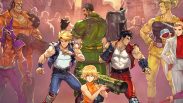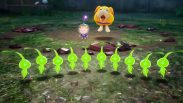We are now some six years and counting into the Nintendo Switch’s lifespan, and the hybrid system is home to an astounding library of classic games from dozens of famous franchises. While Square Enix titles like Final Fantasy VII and Final Fantasy X are coming up to a couple of years on the device, it’s the earlier entries in that series that have been eluding the console.
That is all ready to change, though, as Square Enix brings the first six entries in the Final Fantasy series to Nintendo Switch with the snappily titled Final Fantasy Pixel Remasters. Already a hit on Steam, these upgraded ports of the original NES and SNES titles bring them into the modern day with widescreen support, new orchestral versions of the soundtracks, and a painstakingly recreated pixel art style.
While it might not be obvious when looking only at the new versions, each title is much more vibrant and clear, thanks in no small part to original pixel artist Kazuko Shibuya lending her talents once again. The original spirit and intent are here with each entry but with a glorious modern update that pays homage to the classic releases while making them easier to play than ever before.
As there are six different titles included in this collection – each available to purchase alone or as part of a six-game package – three members of the Pocket Tactics team who are familiar with the games are taking two titles each and giving our impressions of the remakes after a few hours of gameplay. Some of these titles are over three decades old at this point, so individual reviews of each game’s story are redundant.
For the truly uninitiated, the Final Fantasy Pixel Remasters are a collection of six classic RPG titles from the NES and SNES that are the earliest entries in the juggernaut Final Fantasy franchise. Each title is a turn-based adventure, with a story normally surrounding the crystals of light or similar fantasy tropes, with beasts like dragons, sea serpents, and the infamous Chocobos populating the gorgeous lands of each entry.
I am playing Final Fantasy V and Final Fantasy VI, both widely considered to be some of the best RPG action ever to grace the SNES. Both of these titles lay the blueprints for what RPG games are to this very day, and the introductions of elements such as the job systems mean that they are both still so fun to experiment with.
If you have to pick one, Final Fantasy VI is likely the better pick, mainly thanks to a slighter darker story that staps marginally away from the tropes of the previous five entries. It also has a great cast of characters, bosses, and an absolutely stellar soundtrack. If you can stretch to two, definitely grab FFV as well, but FFVI is likely the standout here.
First of all, for the price of these releases, you might be wondering what these remasters actually get you in terms of improvements. This collection isn’t quite the transformation of something like Square Enix’s recent Live-A-Live HD-2D remake, as presumably treating six different games to such a drastic overhaul is a hefty workload with very little chance of a return on each and every entry.
Instead, what we have here is a spit and polish to the original artwork, but remakes that also make some subtle changes that might be missed. The aforementioned pixel art is the most noticeable change, looking absolutely glorious both handheld and docked. Any fan of the original titles is sure to be pleased with the careful attention to detail, and while an HD-2D style remake would be nice, there’s no denying how great this collection still looks.
The original pixel art is iconic and gets better with each instalment. The more recent titles like Final Fantasy V and Final Fantasy VI especially stand the test of time, with detailed enemy art and a collection of great outfits for each job class. Effects like snow or rain look better than ever, and even some of the basic Mode-7 3D visual effects from the SNES are intact, looking crystal clear. The performance seems to run at a solid 60 as well, though there is a tiny bit of stuttering in cutscenes.
![]()
There’s no slowdown in any gameplay as far as I can tell, and after about a dozen hours, split between Final Fantasy V and Final Fantasy VI, any performance issues are incredibly rare. Presentation around the board is also great, and menus and UI are also updated, proving much more readable, which is fantastic for any RPG where most of the game is about reading text and menus.
Much furore is findable on the internet in regards to the ‘improved’ font of the Final Fantasy Pixel Remasters, but for the Switch port, there is a new ‘classic’ font option that offers up a clear, pixelated version that is much more pleasing to the eye. The soundtrack also sounds absolutely fantastic, whether you listen to the new orchestral versions or swap to the 8-bit originals.
There’s the option to swap between the two styles of soundtrack as well as a music player within the menu, should you wish to simply listen to the amazing tracks in each entry. On top of this, concept art and bestiaries are present in each title, allowing you a glimpse into the development of these classics, and a look at some of the best fantasy concept art ever imagined. It’s not quite as comprehensive as something like the TMNT Cowabunga Collection, but there is still a lot to love here.
In terms of actual improvements, much like many modern ports, there’s the option to fiddle with difficulty to get the gameplay experience you want. You can speed up battles, text speed, and even change the amount of EXP, money, and job points you get from each battle. There is also the option to auto-battle, should you want to simply experience the story of these classic games again.
There are a couple of weird omissions, but they are minor. In the graphics options, you can choose to display the colourful and detailed remastered visuals, or there’s a classic option that attempts to recreate the scanlines of old CRT televisions. This is great, but an option for a 4:3 display, or perhaps even the ability to swap to the original art style, would be really lovely. It’s a minor quibble as the games look amazing, but as a comprehensive release of those classics, it would be nice to play them as they first appeared.
My only other complaint is the price, as the total collection in one bundle costs $74.99 (£64.99), or they can be bought individually from prices ranging from $11.99 (£9.50) for the original Final Fantasy to $17.99 (£14.99) for Final Fantasy VI. It’s great to have the option to buy them piecemeal if you only want to check out the newer games such as FFV and FFVI, but even buying the bundle, buying each entry is going to set you back.
This isn’t to undercut the work done to these titles, as each entry looks and runs great, but it’s hard not to look at the comparative price of recent releases such as the TMNT: Cowabunga Collection or Metroid Prime Remastered, and wonder if consumers are actually getting enough to demand the high price.
The titles will surely go on sale at some point, but for now, even with the improvements, I would only recommend the entire bundle to the most hardcore Final Fantasy fans out there.
Finally, our other two writers are popping in with their impressions of the titles after spending several hours getting to grips with each entry.
Kayleigh Partleton (Final Fantasy and Final Fantasy II): Ah, Final Fantasy, a terrific NES game that remains one of the best titles on the platform. Therefore, unsurprisingly, getting to experience the first Final Fantasy game in its pixelated glory on Nintendo Switch is nothing short of a treat. The characters you meet are as fantastic as ever. The combat remains fun and is exactly what you expect from a strategy RPG, alongside numerous classes that enable you to approach your adventure as you see fit.
The same is true of FFII in the pixel collection, another timeless classic from the NES era. If you’re a fan of the original Final Fantasy II, or long to experience what this great game has to offer, you can’t go wrong with this title. The fact it comes with five other games is nothing short of a bonus. The music design is fantastic (a common theme in the Final Fantasy franchise), and like its counterparts, the combat experience is second to none in the realm of strategy RPGs.
Ben Johnson (Final Fantasy III and Final Fantasy IV): Final Fantasy III and IV bridge the gap between the NES and SNES era of the legendary series. While the two games only came out 14 months apart from each other, they’re incredibly different. FFIII is the best of the NES lot, and the pixel remaster runs slickly. The quality-of-life improvements are welcome, and the battle theme gets nicely bombastic in the new arrangement.
Meanwhile, Final Fantasy IV is the first of the SNES trilogy, and, in some ways may, be the best of the whole package. An engaging story, wide cast of characters, excellent battle system, and wonderful world to explore mean it’s the one I’m itching to get back to most. All the above QoL and soundtrack bonuses apply here, too.
Another thing that applies to both games is that they’ve stood the test of time. I overrun my lunch break taking down the Djinn in FFIII because I was having such a good time. These are old games, sure, but any Final Fantasy fan will feel right at home.

The Final Fantasy Pixel Remasters are finely crafted love letters to both the original releases and their many fans. The gorgeously detailed updates to the iconic pixel art look incredible on the big screen, and gameplay improvements mean there is no better way to play any of these iconic titles. The price is something of a sticking point, however, so if you only want to grab a couple of entries, maybe wait for a sale.
For even more great turn-based adventures, check out our guides to the best Switch RPGs, and the best mobile RPGs.
Final Fantasy Pixel Remasters Nintendo Switch review
Six iconic RPG titles now look and play better than ever, and the portability of the Nintendo Switch – as well as the great performance – mean this could be the perfect way to play each and every one. The Final Fantasy Pixel Remasters are joyous celebration of classic gaming that any RPG fan will appreciate, so long as you can stomach the price.











